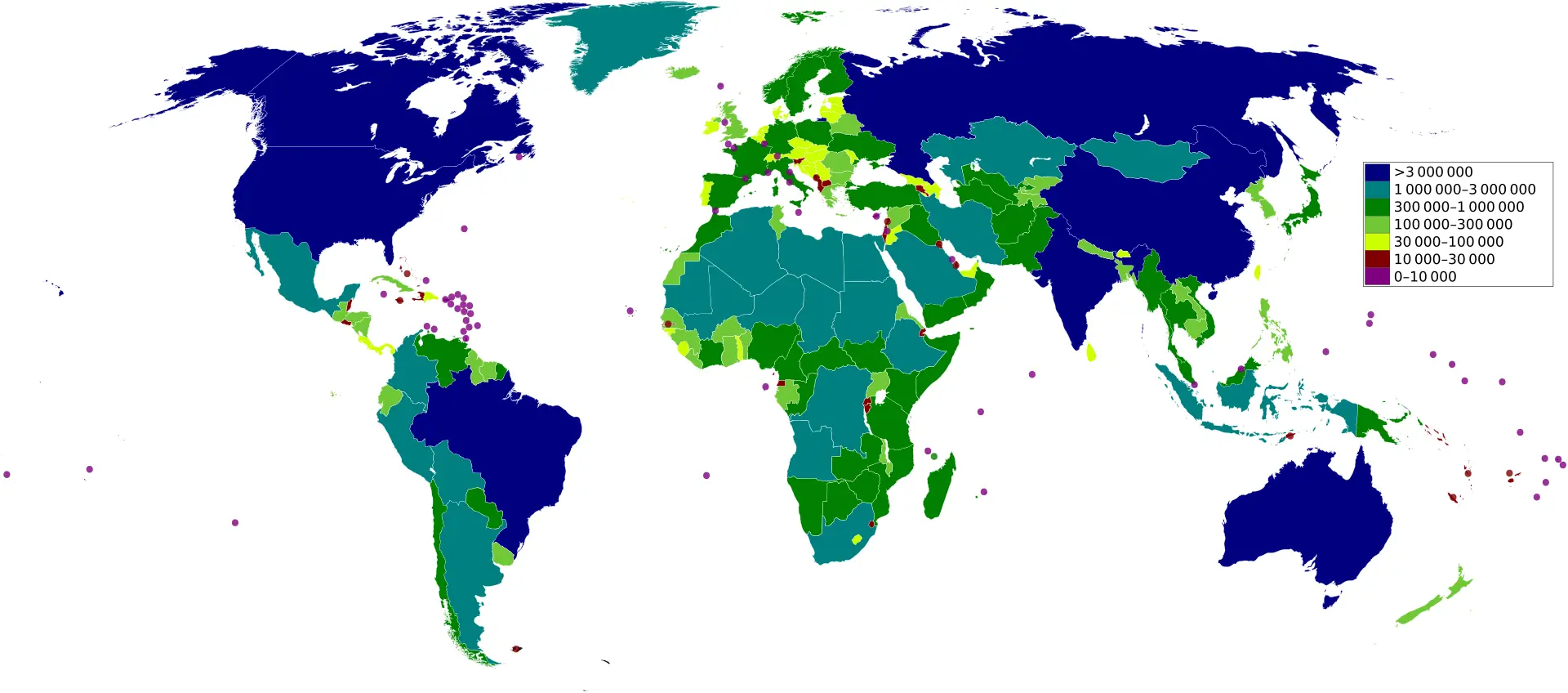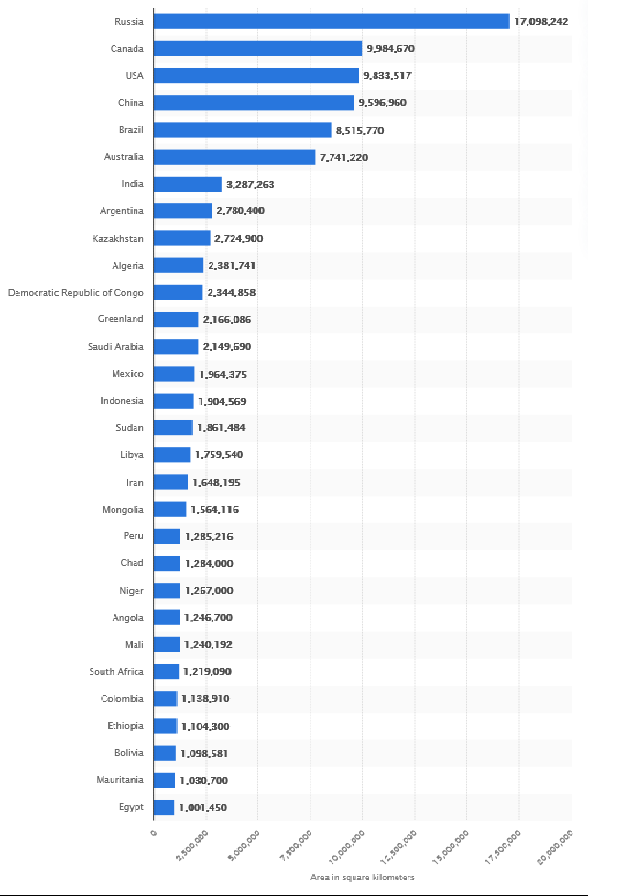When it comes to land area, not all countries are created equal. Some nations span vast continents, while others are just a fraction of a city. This article ranks the world’s largest countries and dependencies by total area, measured in square miles and square kilometers.
1- Russia – 6,592,850 sq mi (17,075,400 sq km)
Undisputed as the largest country on Earth, Russia covers a massive portion of Europe and Asia. Its vast terrain includes tundras, mountains, forests, and over 85,631 square miles (221,783 sq km) of inland water.
Fun Facts About Russia’s Size
- Russia is the largest country in the world by land area, covering 17.1 million square kilometers—making it more than twice the size of the second-largest country, Canada.
- If Russia were split into two equal parts, each would still be larger than the contiguous United States.
- The Trans-Siberian Railway, which spans 9,289 kilometers, is the longest railway line in the world.
- Russia’s coastline stretches over 37,000 kilometers, touching the Arctic and Pacific Oceans.
- Russia spans 4,000 kilometers from west to east and 2,000 kilometers from north to south, making it the largest country to span multiple continents, including both Europe and Asia.
- The country shares borders with sixteen countries, including China, India, Finland, Norway, and Ukraine.
- Russia is home to the Siberian Taiga, the largest forest in the world, covering over 8 million square kilometers and stretching across much of the country.
- Russia’s coastline stretches 37,653 kilometers, touching the Arctic Ocean, Pacific Ocean, and several seas, making it the longest coastline in the world.
- Despite its size, much of Russia remains sparsely populated, with large regions like Siberia having few inhabitants due to harsh climates and rugged terrain.
2- Canada – 3,855,103 sq mi (9,984,670 sq km)
The second-largest country, Canada, is home to stunning landscapes, thousands of lakes, and 60,093 square miles (155,640 sq km) of Great Lakes water. Its vast wilderness stretches from the Atlantic to the Pacific and up to the Arctic.
Fun Facts About Canada’s Size
- If Canada were placed over Europe, it would stretch from Portugal to the Ural Mountainsin Russia.
- Canada has the longest coastline in the world, stretching over 202,080 kilometers—enough to circle the Earth five times!
- Canada spans six time zones, meaning when it’s morning in Vancouver, it’s already afternoon in St. John’s, Newfoundland.
- Canada has more lakes than the rest of the world combined, with over 2 million lakescovering its landscape.
- The border between Canada and the United Statesis the longest international border in the world, stretching 8,891 kilometers.
- Canada’s Wood Buffalo National Parkis the largest national park in North America, bigger than the entire country of Switzerland.
- Despite being the second-largest country in the world, Canada has a population of just 40 million people, making it one of the least densely populated countries.
3- China – 3,705,407 sq mi (9,596,960 sq km)
China, the largest country in Asia, features diverse topography, from the towering Himalayas to expansive deserts and bustling megacities. It is home to the world’s highest peak, Mount Everest.
Fun Facts About China’s Size
- China is the third-largest country in the world by land area, covering 6 million square kilometers—almost the same size as the entire continent of Europe.
- China shares borders with 14 countries, including Russia, India, and Vietnam, making it one of the most neighbor-rich nations in the world.
- The Great Wall of China, one of the largest construction projects in history, stretches over 21,000 kilometers—long enough to cross the United States six times.
- China spans five time zones, but the entire country officially uses Beijing Time(UTC+8) for consistency.
- China’s territorial waterscover approximately 7 million square kilometers, including the South China Sea and the East China Sea.
- The Yangtze River, China’s longest river, stretches 6,300 kilometers, making it the third-longest river in the world after the Amazon and the Nile.
- Despite its massive size, 94% of China’s populationlives in the eastern half of the country, while the western regions are sparsely populated due to mountains and deserts.
- China’s Xinjiang regionalone is 6 million square kilometers, making it larger than Iran and almost four times the size of California.
4- United States – 3,677,649 sq mi (9,525,067 sq km)
Including Alaska and Hawaii, the U.S. ranks as the fourth-largest country. It boasts a wide variety of climates, ranging from arid deserts to lush forests and snowy mountain ranges.
Fun Facts About the USA’s Size
- The United States is the fourth-largest country in the world by land area, covering 5 million square kilometers—almost as large as the entire continent of Europe.
- The USA spans six time zones, from Eastern Time in New York to Hawaii-Aleutian Time in Hawaii.
- Alaska, the largest state in the USA, is so big that it could fit 22 smaller stateswithin its borders. If Alaska were a country, it would be the 7th largest in the world.
- The contiguous United States (the 48 connected states) stretches 4,500 kilometersfrom the Atlantic Ocean to the Pacific Ocean.
- The USA shares borders with only two countries: Canada to the north and Mexico to the south. The border with Canada is the longest international border in the worldat 8,891 kilometers.
- The Mississippi River, one of the longest rivers in the world, flows 3,730 kilometersthrough the heart of the country.
- Texas, the second-largest state, is so vast that it’s larger than many countries, including France and Germany.
- Despite its size, the USA is the third-most populous country in the world, with over 330 million people.
5- Brazil – 3,287,956 sq mi (8,515,767 sq km)
As the largest country in South America, Brazil is home to the Amazon Rainforest, the world’s largest tropical rainforest. It also has one of the longest river systems, the Amazon River.
Fun Facts About Brazil’s Size
- Brazil is the fifth-largest country in the world by land area, covering 5 million square kilometers—larger than the contiguous United States.
- Brazil spans four time zones, from UTC-2 to UTC-5, and it’s the largest country in both South Americaand the Southern Hemisphere.
- The Amazon Rainforest, which covers about 60% of Brazil’s land area, is the largest tropical rainforest in the world and produces 20% of the Earth’s oxygen.
- Brazil shares borders with 10 countries, including every South American nation except Chile and Ecuador.
- The Amazon River, which flows through Brazil, is the second-longest river in the worldat 6,400 kilometers and has the largest drainage basin.
- Brazil’s coastline stretches 7,491 kilometersalong the Atlantic Ocean, making it one of the longest coastlines in the world.
- The country is so large that it’s almost as big as Europe—if you placed Brazil over Europe, it would stretch from Portugal to the Ural Mountains in Russia.
- Despite its massive size, Brazil’s population is concentrated in urban areas, with over 87% of Braziliansliving in cities.
6- Australia – 2,969,907 sq mi (7,692,024 sq km)
Australia is the smallest continent but the sixth-largest country. It features vast deserts, unique wildlife, and coastal cities like Sydney and Melbourne. It is also the only country that is a continent.
Fun Facts About Australia’s Size
- Australia is the sixth-largest country in the world by land area, covering 7 million square kilometers—about the same size as the contiguous United States.
- Despite its massive size, Australia is the smallest continentand the largest island in the world.
- Australia spans three time zones, but during daylight saving time, some regions operate on half-hour differences, creating unique timekeeping.
- The country is so vast that the distance between Sydney and Perth(east to west) is about 4,000 kilometers, roughly the same as the distance between New York and Los Angeles.
- Australia’s coastline stretches 25,760 kilometers, making it one of the longest coastlines in the world.
- The Great Barrier Reef, located off Australia’s northeastern coast, is the largest coral reef system in the world, stretching over 2,300 kilometers.
- Australia is home to the largest cattle station in the world, Anna Creek Station, which is bigger than Israelat 24,000 square kilometers.
- Despite its size, Australia has a relatively small population of 26 million people, making it one of the least densely populated countriesin the world.
7- India – 1,269,219 sq mi (3,287,263 sq km)
India, the seventh-largest country, is known for its geographical diversity, from the Himalayas to the Indian Ocean. It has one of the most varied climates in the world.
Fun Facts About India’s Size
- India is the seventh-largest country in the world by land area, covering 3 million square kilometers—about one-third the size of the United States.
- Despite its relatively smaller land area, India is the second-most populous country in the world, with over 4 billion people.
- India spans two time zones, but the entire country officially uses Indian Standard Time (IST), which is UTC+5:30.
- The country stretches 3,214 kilometersfrom north to south and 2,933 kilometers from east to west, making it a vast and diverse nation.
- India shares borders with seven countries: Pakistan, China, Nepal, Bhutan, Bangladesh, Myanmar, and Afghanistan.
- The Thar Desertin northwestern India covers 200,000 square kilometers, making it one of the largest deserts in the world.
- India’s coastline stretches 7,516 kilometers, touching the Arabian Sea, the Bay of Bengal, and the Indian Ocean.
- Despite its size, India is one of the most densely populated countries, with an average of 464 people per square kilometer.
8- Argentina – 1,073,500 sq mi (2,780,400 sq km)
The largest Spanish-speaking country, Argentina features vast plains, the Andes Mountains, and the stunning Patagonia region.
Fun Facts About Argentina’s Size
- Argentina is the eighth-largest country in the world by land area, covering 78 million square kilometers—making it the second-largest country in South America after Brazil.
- Despite its vast land area, Argentina has a relatively low population density, with about 17 people per square kilometer.
- Argentina spans two time zones, but the entire country officially uses Argentina Time (ART), which is UTC-3.
- The country stretches 4,725 kilometers from north to south and 1,400 kilometers from east to west, making it one of the longest countries in the world.
- Argentina shares borders with five countries: Chile, Bolivia, Paraguay, Brazil, and Uruguay.
- The Monte Desert in western Argentina covers 467,500 square kilometers, making it one of the largest deserts in South America.
- Argentina’s Atlantic coastline stretches 4,989 kilometers, providing access to major port cities like Buenos Aires and Mar del Plata.
- Despite its size, Argentina is one of the least densely populated major countries, with large uninhabited areas in Patagonia and the Andes region.
9- Kazakhstan – 1,052,100 sq mi (2,724,900 sq km)
The largest landlocked country, Kazakhstan spans Central Asia and Europe. It features steppe landscapes, deserts, and important historical trade routes.
Fun Facts About Kazakhstan’s Size
- Kazakhstan is the ninth-largest country in the world by land area, covering 72 million square kilometers—making it the largest landlocked country on Earth.
- Despite its vast land area, Kazakhstan has a relatively low population density, with about 7 people per square kilometer.
- Kazakhstan spans five time zones, but the entire country officially uses Kazakhstan Time (UTC+5 and UTC+6).
- The country stretches 3,000 kilometers from north to south and 1,900 kilometers from east to west, making it one of the world’s most expansive nations.
- Kazakhstan shares borders with five countries: Russia, China, Kyrgyzstan, Uzbekistan, and Turkmenistan.
- The Kyzylkum and Betpak-Dala deserts in southern Kazakhstan cover over 300,000 square kilometers, making them among the largest deserts in Central Asia.
- Kazakhstan’s Caspian Sea coastline stretches 1,894 kilometers, despite being a landlocked country, as the Caspian Sea is an inland body of water.
- Despite its size, Kazakhstan has large uninhabited regions, with vast steppe landscapes, deserts, and mountain ranges, making it one of the most sparsely populated countries in the world.
10- Algeria – 919,595 sq mi (2,381,740 sq km)
Algeria is Africa’s largest country, dominated by the Sahara Desert. Its Mediterranean coastline provides a striking contrast to the arid interior.
Fun Facts About Algeria’s Size
- Algeria is the tenth-largest country in the world by land area, covering 38 million square kilometers—making it the largest country in Africa.
- Despite its vast land area, Algeria has a relatively low population density, with about 20 people per square kilometer.
- Algeria spans one time zone, officially using Central European Time (UTC+1).
- The country stretches 2,400 kilometers from north to south and 1,800 kilometers from east to west, making it one of the most expansive nations in Africa.
- Algeria shares borders with seven countries: Tunisia, Libya, Niger, Mali, Mauritania, Western Sahara, and Morocco.
- The Sahara Desert covers over 80% of Algeria’s land, making it one of the most arid nations in the world.
- Algeria’s Mediterranean coastline stretches 1,622 kilometers, providing access to major port cities like Algiers, Oran, and Annaba.
- Despite its size, Algeria’s population is concentrated in the northern coastal region, while the vast southern desert remains largely uninhabited.
11- Democratic Republic of the Congo – 905,568 sq mi (2,345,409 sq km)
The second-largest country in Africa, the DRC is rich in natural resources, rainforests, and the mighty Congo River.
Fun Facts About the Democratic Republic of the Congo’s Size
- The Democratic Republic of the Congo (DRC) is the eleventh-largest country in the world by land area, covering 34 million square kilometers—making it the largest country in sub-Saharan Africa.
- Despite its vast land area, the Democratic Republic of the Congo has a relatively low population density, with about 50 people per square kilometer.
- The country spans two time zones, officially using West Africa Time (UTC+1) and Central Africa Time (UTC+2).
- The country stretches 2,190 kilometers from north to south and 2,250 kilometers from east to west, making it one of the largest nations in Africa.
- The Democratic Republic of the Congo shares borders with nine countries: Angola, Zambia, Tanzania, Burundi, Rwanda, Uganda, South Sudan, the Central African Republic, and the Republic of the Congo.
- The Congo Rainforest, covering over 5 million square kilometers, is the second-largest tropical rainforest in the world after the Amazon.
- The Democratic Republic of the Congo has a 37-kilometer coastline along the Atlantic Ocean, making it one of the few land-rich countries with a short coast.
- Despite its size, much of the country remains covered in dense rainforest, rivers, and mountains, with large regions being difficult to access.
12- Greenland (Denmark) – 836,330 sq mi (2,166,086 sq km)
Although Greenland is a dependency of Denmark, it is the largest island in the world, mostly covered in ice.
Fun Facts About Greenland’s Size
- Greenland is the twelfth-largest territory in the world by land area, covering 16 million square kilometers—making it the largest island on Earth.
- Despite its vast land area, Greenland has an extremely low population density, with about 03 people per square kilometer, making it one of the most sparsely populated places in the world.
- Greenland spans four time zones, officially using Western Greenland Time (UTC-3), Atlantic Time (UTC-4), Eastern Greenland Time (UTC-1), and Denmark Time (UTC+0).
- The island stretches 2,670 kilometers from north to south and 1,050 kilometers from east to west, making it one of the longest and widest islands in the world.
- Greenland shares no land borders but is geographically close to Canada, Iceland, and Norway, with sea routes connecting it to these regions.
- The Greenland Ice Sheet, covering around 7 million square kilometers, is the second-largest ice mass in the world after Antarctica.
- Greenland’s coastline stretches 44,087 kilometers, making it one of the longest coastlines in the world due to its many fjords and inlets.
- Despite its size, over 80% of Greenland is covered in ice, with most of its small population living along the ice-free coastal areas.
13- Saudi Arabia – 830,000 sq mi (2,149,690 sq km)
The largest country in the Middle East, Saudi Arabia is home to vast deserts, including the Rub’ al Khali (Empty Quarter).
Fun Facts About Saudi Arabia’s Size
- Saudi Arabia is the thirteenth-largest country in the world by land area, covering 15 million square kilometers—making it the largest country in the Middle East.
- Despite its vast land area, Saudi Arabia has a relatively low population density, with about 16 people per square kilometer.
- Saudi Arabia spans one time zone, officially using Arabian Standard Time (UTC+3).
- The country stretches 2,250 kilometers from north to south and 1,450 kilometers from east to west, making it one of the most expansive nations in the region.
- Saudi Arabia shares borders with eight countries: Jordan, Iraq, Kuwait, Qatar, the United Arab Emirates, Oman, Yemen, and Bahrain (via a causeway).
- The Rub’ al Khali (Empty Quarter) in southern Saudi Arabia covers 650,000 square kilometers, making it the largest continuous sand desert in the world.
- Saudi Arabia’s coastline stretches 2,640 kilometers, touching both the Red Sea and the Arabian Gulf, providing access to key port cities like Jeddah, Dammam, and Yanbu.
- Despite its size, Saudi Arabia has no permanent rivers, relying instead on underground aquifers and desalination plants for water supply.
14- Mexico – 758,449 sq mi (1,964,375 sq km)
Mexico features diverse landscapes, from deserts and beaches to mountains and rainforests. It has a rich cultural heritage dating back to ancient civilizations.
Fun Facts About Mexico’s Size
- Mexico is the fourteenth-largest country in the world by land area, covering 96 million square kilometers—making it the third-largest country in North America after Canada and the United States.
- Despite its vast land area, Mexico has a relatively high population density, with about 66 people per square kilometer.
- Mexico spans four time zones, officially using Pacific Time (UTC-8), Mountain Time (UTC-7), Central Time (UTC-6), and Eastern Time (UTC-5).
- The country stretches 3,200 kilometers from north to south and 1,100 kilometers from east to west, making it one of the longest and most diverse nations in the Americas.
- Mexico shares borders with three countries: the United States, Guatemala, and Belize.
- The Chihuahuan Desert, covering 362,000 square kilometers, is the largest desert in North America and spans parts of both Mexico and the United States.
- Mexico’s coastline stretches 9,330 kilometers, touching the Pacific Ocean, the Gulf of Mexico, and the Caribbean Sea, providing access to major port cities like Acapulco, Veracruz, and Cancún.
- Despite its size, Mexico has a highly varied landscape, with deserts, jungles, mountains, and more than 1,000 volcanoes, including Popocatépetl, one of the most active volcanoes in the world.
15- Indonesia – 735,358 sq mi (1,904,569 sq km)
An archipelago of over 17,000 islands, Indonesia is the largest island country and home to unique wildlife, including orangutans and Komodo dragons.
Fun Facts About Indonesia’s Size
- Indonesia is the fifteenth-largest country in the world by land area, covering 91 million square kilometers—making it the largest archipelago nation on Earth.
- Despite its vast land area, Indonesia has a relatively high population density, with about 151 people per square kilometer.
- Indonesia spans three time zones, officially using Western Indonesia Time (UTC+7), Central Indonesia Time (UTC+8), and Eastern Indonesia Time (UTC+9).
- The country stretches 5,120 kilometers from west to east and 1,760 kilometers from north to south, making it one of the most geographically extensive nations in the world.
- Indonesia shares land borders with three countries: Malaysia, Papua New Guinea, and Timor-Leste.
- The Kalimantan Rainforest on the island of Borneo, covering 544,150 square kilometers, is one of the largest and most biodiverse rainforests in the world.
- Indonesia’s coastline stretches 54,716 kilometers, making it the second-longest coastline in the world, touching the Indian Ocean, the Pacific Ocean, and the South China Sea.
- Despite its size, Indonesia consists of over 17,000 islands, with about 6,000 inhabited, making it one of the most fragmented yet diverse countries in the world.
16- Sudan – 718,723 sq mi (1,861,484 sq km)
Sudan was once Africa’s largest country before the secession of South Sudan in 2011. It remains a land of vast deserts and the Nile River.
Fun Facts About Sudan’s Size
- Sudan is the sixteenth-largest country in the world by land area, covering 86 million square kilometers—making it the third-largest country in Africa after Algeria and the Democratic Republic of the Congo.
- Despite its vast land area, Sudan has a relatively low population density, with about 24 people per square kilometer.
- Sudan spans one time zone, officially using Central Africa Time (UTC+2).
- The country stretches 2,000 kilometers from north to south and 1,600 kilometers from east to west, making it one of the largest and most diverse nations in Africa.
- Sudan shares borders with seven countries: Egypt, Eritrea, Ethiopia, South Sudan, the Central African Republic, Chad, and Libya.
- The Sahara Desert covers much of northern Sudan, making the country one of the most arid in Africa.
- Sudan’s Red Sea coastline stretches 853 kilometers, providing access to port cities like Port Sudan.
- Despite its size, much of Sudan is sparsely populated, with the majority of the population living along the Nile River and in urban areas.
17- Libya – 679,362 sq mi (1,759,541 sq km)
Libya is dominated by the Sahara Desert, with over 90% of its land covered by arid terrain.
Fun Facts About Libya’s Size
- Libya is the sixteenth-largest country in the world by land area, covering 76 million square kilometers—making it the fourth-largest country in Africa.
- Despite its vast land area, Libya has a relatively low population density, with about 4 people per square kilometer, making it one of the least densely populated countries in the world.
- Libya spans 1,760 kilometers from north to south and 1,300 kilometers from east to west, making it one of the widest countries in North Africa.
- The country shares borders with six countries: Egypt, Sudan, Chad, Niger, Algeria, and Tunisia.
- The Libyan Desert, part of the Sahara, covers a large portion of the country, making up about 90% of Libya’s total land area.
- Libya has a 1,770-kilometer coastline along the Mediterranean Sea, providing access to major port cities like Tripoli and Benghazi.
- Despite its size, much of Libya remains sparsely populated, with large regions of desert and few areas of settlement, mainly along the coast.
18- Iran – 636,372 sq mi (1,648,195 sq km)
Iran’s landscape includes vast plateaus, mountains, and deserts, as well as historical cities such as Tehran, Isfahan, and Shiraz.
Fun Facts About Iran’s Size
- Iran is the 17th-largest country in the world by land area, covering 1.65 million square kilometers—about the size of Alaska or three times the size of France.
- Despite its large size, Iran’s population is concentrated in urban areas, with over 85 million people calling it home.
- Iran spans three time zones, but the entire country officially uses Iran Standard Time (IRST), which is UTC+3:30.
- The country stretches 2,250 kilometers from north to south and 1,400 kilometers from east to west, making it a vast and geographically diverse nation.
- Iran shares borders with seven countries: Iraq, Turkey, Armenia, Azerbaijan, Turkmenistan, Afghanistan, and Pakistan.
- The Dasht-e Kavir and Dasht-e Lut deserts cover a significant portion of Iran, with the latter being one of the hottest places on Earth.
- Iran’s coastline stretches 2,440 kilometers, touching the Caspian Sea to the north and the Persian Gulf and Gulf of Oman to the south.
- Despite its arid climate, Iran is home to diverse landscapes, including mountains, forests, and fertile plains, with the Zagros and Alborz mountain ranges dominating much of the terrain.
19- Mongolia – 603,909 sq mi (1,564,116 sq km)
Mongolia, known for its vast steppes and nomadic culture, is the least densely populated country in the world.
Fun Facts About Mongolia’s Size
- Mongolia is the seventeenth-largest country in the world by land area, covering 56 million square kilometers—making it the largest landlocked country in the world.
- Despite its vast land area, Mongolia has a relatively low population density, with about 2 people per square kilometer, making it one of the least densely populated countries in the world.
- Mongolia spans 2,400 kilometers from north to south and 1,000 kilometers from east to west, making it a country with vast and open landscapes.
- The country shares borders with two countries: Russia to the north and China to the south.
- The Gobi Desert, covering 1,295,000 square kilometers, is one of the largest deserts in Asia and a famous natural landmark of Mongolia.
- Mongolia’s coastline is nonexistent, as it is a landlocked country, but it is home to stunning inland lakes such as Lake Khovsgol.
- Despite its size, Mongolia has vast areas of grasslands, steppes, and mountains, with a majority of its population living in the capital city, Ulaanbaatar.
20- Peru – 496,225 sq mi (1,285,216 sq km)
Home to the Amazon Rainforest and the Andes Mountains, Peru is rich in biodiversity and ancient Incan history, including Machu Picchu.
Fun Facts About Peru’s Size
- Peru is the nineteenth-largest country in the world by land area, covering 28 million square kilometers—making it the third-largest country in South America after Brazil and Argentina.
- Despite its vast land area, Peru has a moderate population density, with about 25 people per square kilometer.
- Peru spans 1,300 kilometers from north to south and 500 kilometers from east to west, making it a country with a diverse range of landscapes.
- The country shares borders with five countries: Ecuador, Colombia, Brazil, Bolivia, and Chile.
- Peru is home to the Amazon Rainforest, which covers more than 60% of the country’s territory, making it one of the most biodiverse regions in the world.
- Peru’s coastline stretches 2,414 kilometers, touching the Pacific Ocean, with famous coastal cities like Lima and Arequipa.
- Despite its size, Peru has highly varied geography, with the Andes Mountains running through the country, as well as the vast Amazon Basin and coastal deserts.
Honorable Mentions & Smallest Country
While the list above features the largest nations, the smallest country in the world is Vatican City, covering just 0.17 square miles (0.44 sq km).
Key Insights & Interesting Facts
- Russia is almost twice the size of Canada.
- China and the U.S. are nearly equal in land area.
- Kazakhstan and Mongolia are the only landlocked country in the top 20.
- Algeria overtook Sudan as Africa’s largest country after South Sudan’s independence in 2011.
- Pakistan is the 33rd-largest country in the world by land area, covering 881,913 square kilometers, and is home to the world’s second-highest peak, K2.
List of Countries (and Dependencies) Ranked by Land Area
According to worldometers.info, following is the list of countries (and dependencies) ranked by land area.
Total Area = land area + water bodies (lakes, reservoirs, and rivers)
Km² = square kilometers | mi² = square miles
Search:
| # | Country | Tot. Area (Km²) | Tot. Area (mi²) | Land Area (Km²) | Land Area (mi²) | % of world landmass |
| 1 | Russia | 17,098,242 | 6,601,665 | 16,376,870 | 6,323,142 | 11.0 % |
| 2 | Canada | 9,984,670 | 3,855,101 | 9,093,510 | 3,511,022 | 6.1 % |
| 3 | China | 9,706,961 | 3,747,877 | 9,388,211 | 3,624,807 | 6.3 % |
| 4 | United States | 9,372,610 | 3,618,783 | 9,147,420 | 3,531,837 | 6.1 % |
| 5 | Brazil | 8,515,767 | 3,287,955 | 8,358,140 | 3,227,095 | 5.6 % |
| 6 | Australia | 7,692,024 | 2,969,906 | 7,682,300 | 2,966,151 | 5.2 % |
| 7 | India | 3,287,590 | 1,269,345 | 2,973,190 | 1,147,955 | 2.0 % |
| 8 | Argentina | 2,780,400 | 1,073,518 | 2,736,690 | 1,056,641 | 1.8 % |
| 9 | Kazakhstan | 2,724,900 | 1,052,089 | 2,699,700 | 1,042,360 | 1.8 % |
| 10 | Algeria | 2,381,741 | 919,595 | 2,381,740 | 919,595 | 1.6 % |
| 11 | DR Congo | 2,344,858 | 905,354 | 2,267,050 | 875,313 | 1.5 % |
| 12 | Greenland | 2,166,086 | 836,330 | 410,450 | 158,476 | 0.3 % |
| 13 | Saudi Arabia | 2,149,690 | 830,000 | 2,149,690 | 830,000 | 1.4 % |
| 14 | Mexico | 1,964,375 | 758,449 | 1,943,950 | 750,563 | 1.3 % |
| 15 | Indonesia | 1,904,569 | 735,358 | 1,811,570 | 699,451 | 1.2 % |
| 16 | Sudan | 1,886,068 | 728,215 | 1,765,048 | 681,489 | 1.2 % |
| 17 | Libya | 1,759,540 | 679,362 | 1,759,540 | 679,362 | 1.2 % |
| 18 | Iran | 1,648,195 | 636,371 | 1,628,550 | 628,786 | 1.1 % |
| 19 | Mongolia | 1,564,110 | 603,906 | 1,553,560 | 599,833 | 1.0 % |
| 20 | Peru | 1,285,216 | 496,224 | 1,280,000 | 494,211 | 0.9 % |
| 21 | Chad | 1,284,000 | 495,755 | 1,259,200 | 486,180 | 0.8 % |
| 22 | Niger | 1,267,000 | 489,191 | 1,266,700 | 489,075 | 0.9 % |
| 23 | Angola | 1,246,700 | 481,353 | 1,246,700 | 481,353 | 0.8 % |
| 24 | Mali | 1,240,192 | 478,841 | 1,220,190 | 471,118 | 0.8 % |
| 25 | South Africa | 1,221,037 | 471,445 | 1,213,090 | 468,376 | 0.8 % |
| 26 | Colombia | 1,141,748 | 440,831 | 1,109,500 | 428,380 | 0.7 % |
| 27 | Ethiopia | 1,104,300 | 426,372 | 1,000,000 | 386,102 | 0.7 % |
| 28 | Bolivia | 1,098,581 | 424,164 | 1,083,300 | 418,264 | 0.7 % |
| 29 | Mauritania | 1,030,700 | 397,955 | 1,030,700 | 397,955 | 0.7 % |
| 30 | Egypt | 1,002,450 | 387,048 | 995,450 | 384,345 | 0.7 % |
| 31 | Tanzania | 945,087 | 364,900 | 885,800 | 342,009 | 0.6 % |
| 32 | Nigeria | 923,768 | 356,669 | 910,770 | 351,650 | 0.6 % |
| 33 | Venezuela | 916,445 | 353,841 | 882,050 | 340,561 | 0.6 % |
| 34 | Pakistan | 881,912 | 340,508 | 770,880 | 297,638 | 0.5 % |
| 35 | Namibia | 825,615 | 318,772 | 823,290 | 317,874 | 0.6 % |
| 36 | Mozambique | 801,590 | 309,496 | 786,380 | 303,623 | 0.5 % |
| 37 | Turkey | 783,562 | 302,535 | 769,630 | 297,156 | 0.5 % |
| 38 | Chile | 756,102 | 291,932 | 743,532 | 287,079 | 0.5 % |
| 39 | Zambia | 752,612 | 290,585 | 743,390 | 287,024 | 0.5 % |
| 40 | Myanmar | 676,578 | 261,228 | 653,290 | 252,237 | 0.4 % |
| 41 | Afghanistan | 652,230 | 251,827 | 652,860 | 252,071 | 0.4 % |
| 42 | Somalia | 637,657 | 246,201 | 627,340 | 242,217 | 0.4 % |
| 43 | Central African Republic | 622,984 | 240,535 | 622,980 | 240,534 | 0.4 % |
| 44 | South Sudan | 619,745 | 239,285 | 610,952 | 235,890 | 0.4 % |
| 45 | Ukraine | 603,500 | 233,013 | 579,320 | 223,677 | 0.4 % |
| 46 | Madagascar | 587,041 | 226,658 | 581,795 | 224,632 | 0.4 % |
| 47 | Botswana | 582,000 | 224,711 | 566,730 | 218,816 | 0.4 % |
| 48 | Kenya | 580,367 | 224,081 | 569,140 | 219,746 | 0.4 % |
| 49 | France | 551,695 | 213,011 | 547,557 | 211,413 | 0.4 % |
| 50 | Yemen | 527,968 | 203,850 | 527,970 | 203,850 | 0.4 % |
| 51 | Thailand | 513,120 | 198,117 | 510,890 | 197,256 | 0.3 % |
| 52 | Spain | 505,992 | 195,365 | 498,800 | 192,588 | 0.3 % |
| 53 | Turkmenistan | 488,100 | 188,456 | 469,930 | 181,441 | 0.3 % |
| 54 | Cameroon | 475,442 | 183,569 | 472,710 | 182,514 | 0.3 % |
| 55 | Papua New Guinea | 462,840 | 178,703 | 452,860 | 174,850 | 0.3 % |
| 56 | Sweden | 450,295 | 173,860 | 410,340 | 158,433 | 0.3 % |
| 57 | Uzbekistan | 447,400 | 172,742 | 425,400 | 164,248 | 0.3 % |
| 58 | Morocco | 446,550 | 172,414 | 446,300 | 172,317 | 0.3 % |
| 59 | Iraq | 438,317 | 169,235 | 434,320 | 167,692 | 0.3 % |
| 60 | Paraguay | 406,752 | 157,048 | 397,300 | 153,398 | 0.3 % |
| 61 | Zimbabwe | 390,757 | 150,872 | 386,850 | 149,364 | 0.3 % |
| 62 | Japan | 377,930 | 145,920 | 364,555 | 140,755 | 0.2 % |
| 63 | Germany | 357,114 | 137,882 | 348,560 | 134,580 | 0.2 % |
| 64 | Philippines | 342,353 | 132,183 | 298,170 | 115,124 | 0.2 % |
| 65 | Congo | 342,000 | 132,047 | 341,500 | 131,854 | 0.2 % |
| 66 | Finland | 338,424 | 130,666 | 303,890 | 117,333 | 0.2 % |
| 67 | Vietnam | 331,212 | 127,882 | 310,070 | 119,719 | 0.2 % |
| 68 | Malaysia | 330,803 | 127,724 | 328,550 | 126,854 | 0.2 % |
| 69 | Norway | 323,802 | 125,021 | 365,268 | 141,031 | 0.2 % |
| 70 | Côte d’Ivoire | 322,463 | 124,504 | 318,000 | 122,780 | 0.2 % |
| 71 | Poland | 312,679 | 120,726 | 306,230 | 118,236 | 0.2 % |
| 72 | Oman | 309,500 | 119,499 | 309,500 | 119,499 | 0.2 % |
| 73 | Italy | 301,336 | 116,346 | 294,140 | 113,568 | 0.2 % |
| 74 | Ecuador | 276,841 | 106,889 | 248,360 | 95,892 | 0.2 % |
| 75 | Burkina Faso | 272,967 | 105,393 | 273,600 | 105,638 | 0.2 % |
| 76 | New Zealand | 270,467 | 104,428 | 263,310 | 101,665 | 0.2 % |
| 77 | Gabon | 267,668 | 103,347 | 257,670 | 99,487 | 0.2 % |
| 78 | Western Sahara | 266,000 | 102,703 | 266,000 | 102,703 | 0.2 % |
| 79 | Guinea | 245,857 | 94,926 | 245,720 | 94,873 | 0.2 % |
| 80 | United Kingdom | 242,900 | 93,784 | 241,930 | 93,410 | 0.2 % |
| 81 | Uganda | 241,550 | 93,263 | 199,810 | 77,147 | 0.1 % |
| 82 | Ghana | 238,533 | 92,098 | 227,540 | 87,854 | 0.2 % |
| 83 | Romania | 238,391 | 92,043 | 230,170 | 88,869 | 0.2 % |
| 84 | Laos | 236,800 | 91,429 | 230,800 | 89,112 | 0.2 % |
| 85 | Guyana | 214,969 | 83,000 | 196,850 | 76,004 | 0.1 % |
| 86 | Belarus | 207,600 | 80,155 | 202,910 | 78,344 | 0.1 % |
| 87 | Kyrgyzstan | 199,951 | 77,201 | 191,800 | 74,054 | 0.1 % |
| 88 | Senegal | 196,722 | 75,955 | 192,530 | 74,336 | 0.1 % |
| 89 | Syria | 185,180 | 71,498 | 183,630 | 70,900 | 0.1 % |
| 90 | Cambodia | 181,035 | 69,898 | 176,520 | 68,155 | 0.1 % |
| 91 | Uruguay | 181,034 | 69,898 | 175,020 | 67,576 | 0.1 % |
| 92 | Suriname | 163,820 | 63,251 | 156,000 | 60,232 | 0.1 % |
| 93 | Tunisia | 163,610 | 63,170 | 155,360 | 59,985 | 0.1 % |
| 94 | Bangladesh | 147,570 | 56,977 | 130,170 | 50,259 | 0.1 % |
| 95 | Nepal | 147,181 | 56,827 | 143,350 | 55,348 | 0.1 % |
| 96 | Tajikistan | 143,100 | 55,251 | 139,960 | 54,039 | 0.1 % |
| 97 | Greece | 131,990 | 50,962 | 128,900 | 49,769 | 0.1 % |
| 98 | Nicaragua | 130,373 | 50,337 | 120,340 | 46,464 | 0.1 % |
| 99 | North Korea | 120,538 | 46,540 | 120,410 | 46,491 | 0.1 % |
| 100 | Malawi | 118,484 | 45,747 | 94,280 | 36,402 | 0.1 % |
| 101 | Eritrea | 117,600 | 45,406 | 101,000 | 38,996 | 0.1 % |
| 102 | Benin | 112,622 | 43,484 | 112,760 | 43,537 | 0.1 % |
| 103 | Honduras | 112,492 | 43,433 | 111,890 | 43,201 | 0.1 % |
| 104 | Liberia | 111,369 | 43,000 | 96,320 | 37,189 | 0.1 % |
| 105 | Bulgaria | 110,879 | 42,811 | 108,560 | 41,915 | 0.1 % |
| 106 | Cuba | 109,884 | 42,426 | 106,440 | 41,097 | 0.1 % |
| 107 | Guatemala | 108,889 | 42,042 | 107,160 | 41,375 | 0.1 % |
| 108 | Iceland | 103,000 | 39,769 | 100,250 | 38,707 | 0.1 % |
| 109 | South Korea | 100,210 | 38,691 | 97,230 | 37,541 | 0.1 % |
| 110 | Hungary | 93,028 | 35,918 | 90,530 | 34,954 | 0.1 % |
| 111 | Portugal | 92,090 | 35,556 | 91,590 | 35,363 | 0.1 % |
| 112 | Jordan | 89,342 | 34,495 | 88,780 | 34,278 | 0.1 % |
| 113 | Serbia | 88,361 | 34,116 | 87,460 | 33,768 | 0.1 % |
| 114 | Azerbaijan | 86,600 | 33,436 | 82,658 | 31,914 | 0.1 % |
| 115 | Austria | 83,871 | 32,383 | 82,409 | 31,818 | 0.1 % |
| 116 | United Arab Emirates | 83,600 | 32,278 | 83,600 | 32,278 | 0.1 % |
| 117 | French Guiana | 83,534 | 32,253 | 82,200 | 31,738 | 0.1 % |
| 118 | Czechia | 78,865 | 30,450 | 77,240 | 29,823 | 0.1 % |
| 119 | Panama | 75,417 | 29,119 | 74,340 | 28,703 | 0.0 % |
| 120 | Sierra Leone | 71,740 | 27,699 | 72,180 | 27,869 | 0.0 % |
| 121 | Ireland | 70,273 | 27,133 | 68,890 | 26,599 | 0.0 % |
| 122 | Georgia | 69,700 | 26,911 | 69,490 | 26,830 | 0.0 % |
| 123 | Sri Lanka | 65,610 | 25,332 | 62,710 | 24,212 | 0.0 % |
| 124 | Lithuania | 65,300 | 25,212 | 62,674 | 24,199 | 0.0 % |
| 125 | Latvia | 64,559 | 24,926 | 62,200 | 24,016 | 0.0 % |
| 126 | Togo | 56,785 | 21,925 | 54,390 | 21,000 | 0.0 % |
| 127 | Croatia | 56,594 | 21,851 | 55,960 | 21,606 | 0.0 % |
| 128 | Bosnia and Herzegovina | 51,209 | 19,772 | 51,000 | 19,691 | 0.0 % |
| 129 | Costa Rica | 51,100 | 19,730 | 51,060 | 19,714 | 0.0 % |
| 130 | Slovakia | 49,037 | 18,933 | 48,088 | 18,567 | 0.0 % |
| 131 | Dominican Republic | 48,671 | 18,792 | 48,320 | 18,656 | 0.0 % |
| 132 | Estonia | 45,227 | 17,462 | 42,390 | 16,367 | 0.0 % |
| 133 | Denmark | 43,094 | 16,639 | 42,430 | 16,382 | 0.0 % |
| 134 | Netherlands | 41,850 | 16,158 | 33,720 | 13,019 | 0.0 % |
| 135 | Switzerland | 41,284 | 15,940 | 39,516 | 15,257 | 0.0 % |
| 136 | Bhutan | 38,394 | 14,824 | 38,117 | 14,717 | 0.0 % |
| 137 | Taiwan | 36,193 | 13,974 | 35,410 | 13,672 | 0.0 % |
| 138 | Guinea-Bissau | 36,125 | 13,948 | 28,120 | 10,857 | 0.0 % |
| 139 | Moldova | 33,846 | 13,068 | 32,850 | 12,683 | 0.0 % |
| 140 | Belgium | 30,528 | 11,787 | 30,280 | 11,691 | 0.0 % |
| 141 | Lesotho | 30,355 | 11,720 | 30,360 | 11,722 | 0.0 % |
| 142 | Armenia | 29,743 | 11,484 | 28,470 | 10,992 | 0.0 % |
| 143 | Solomon Islands | 28,896 | 11,157 | 27,990 | 10,807 | 0.0 % |
| 144 | Albania | 28,748 | 11,100 | 27,400 | 10,579 | 0.0 % |
| 145 | Equatorial Guinea | 28,051 | 10,831 | 28,050 | 10,830 | 0.0 % |
| 146 | Burundi | 27,834 | 10,747 | 25,680 | 9,915 | 0.0 % |
| 147 | Haiti | 27,750 | 10,714 | 27,560 | 10,641 | 0.0 % |
| 148 | Rwanda | 26,338 | 10,169 | 24,670 | 9,525 | 0.0 % |
| 149 | Republic of North Macedonia | 25,713 | 9,928 | 25,220 | 9,737 | 0.0 % |
| 150 | Djibouti | 23,200 | 8,958 | 23,180 | 8,950 | 0.0 % |
| 151 | Belize | 22,966 | 8,867 | 22,810 | 8,807 | 0.0 % |
| 152 | El Salvador | 21,041 | 8,124 | 20,720 | 8,000 | 0.0 % |
| 153 | Israel | 20,770 | 8,019 | 21,640 | 8,355 | 0.0 % |
| 154 | Slovenia | 20,273 | 7,827 | 20,140 | 7,776 | 0.0 % |
| 155 | New Caledonia | 18,575 | 7,172 | 18,280 | 7,058 | 0.0 % |
| 156 | Fiji | 18,272 | 7,055 | 18,270 | 7,054 | 0.0 % |
| 157 | Kuwait | 17,818 | 6,880 | 17,820 | 6,880 | 0.0 % |
| 158 | Eswatini | 17,364 | 6,704 | 17,200 | 6,641 | 0.0 % |
| 159 | Timor-Leste | 14,874 | 5,743 | 14,870 | 5,741 | 0.0 % |
| 160 | Bahamas | 13,943 | 5,383 | 10,010 | 3,865 | 0.0 % |
| 161 | Montenegro | 13,812 | 5,333 | 13,450 | 5,193 | 0.0 % |
| 162 | Vanuatu | 12,189 | 4,706 | 12,190 | 4,707 | 0.0 % |
| 163 | Falkland Islands | 12,173 | 4,700 | 12,170 | 4,699 | 0.0 % |
| 164 | Qatar | 11,586 | 4,473 | 11,610 | 4,483 | 0.0 % |
| 165 | Jamaica | 10,991 | 4,244 | 10,830 | 4,181 | 0.0 % |
| 166 | Gambia | 10,689 | 4,127 | 10,120 | 3,907 | 0.0 % |
| 167 | Lebanon | 10,452 | 4,036 | 10,230 | 3,950 | 0.0 % |
| 168 | Cyprus | 9,251 | 3,572 | 9,240 | 3,568 | 0.0 % |
| 169 | Puerto Rico | 8,870 | 3,425 | 8,870 | 3,425 | 0.0 % |
| 170 | State of Palestine | 6,220 | 2,402 | 6,020 | 2,324 | 0.0 % |
| 171 | Brunei Darussalam | 5,765 | 2,226 | 5,270 | 2,035 | 0.0 % |
| 172 | Trinidad and Tobago | 5,130 | 1,981 | 5,130 | 1,981 | 0.0 % |
| 173 | French Polynesia | 4,167 | 1,609 | 3,660 | 1,413 | 0.0 % |
| 174 | Cabo Verde | 4,033 | 1,557 | 4,030 | 1,556 | 0.0 % |
| 175 | Samoa | 2,842 | 1,097 | 2,830 | 1,093 | 0.0 % |
| 176 | Luxembourg | 2,586 | 998 | 2,590 | 1,000 | 0.0 % |
| 177 | Réunion | 2,511 | 970 | 2,500 | 965 | 0.0 % |
| 178 | Mauritius | 2,040 | 788 | 2,030 | 784 | 0.0 % |
| 179 | Comoros | 1,862 | 719 | 1,861 | 719 | 0.0 % |
| 180 | Guadeloupe | 1,628 | 629 | 1,690 | 653 | 0.0 % |
| 181 | Faeroe Islands | 1,393 | 538 | 1,396 | 539 | 0.0 % |
| 182 | Martinique | 1,128 | 436 | 1,060 | 409 | 0.0 % |
| 183 | China, Hong Kong SAR | 1,104 | 426 | 1,050 | 405 | 0.0 % |
| 184 | Sao Tome and Principe | 964 | 372 | 960 | 371 | 0.0 % |
| 185 | Turks and Caicos Islands | 948 | 366 | 950 | 367 | 0.0 % |
| 186 | Kiribati | 811 | 313 | 810 | 313 | 0.0 % |
| 187 | Bahrain | 765 | 295 | 760 | 293 | 0.0 % |
| 188 | Dominica | 751 | 290 | 750 | 290 | 0.0 % |
| 189 | Tonga | 747 | 288 | 720 | 278 | 0.0 % |
| 190 | Singapore | 710 | 274 | 700 | 270 | 0.0 % |
| 191 | Micronesia | 702 | 271 | 700 | 270 | 0.0 % |
| 192 | Saint Lucia | 616 | 238 | 610 | 236 | 0.0 % |
| 193 | Isle of Man | 572 | 221 | 570 | 220 | 0.0 % |
| 194 | Guam | 549 | 212 | 540 | 208 | 0.0 % |
| 195 | Andorra | 468 | 181 | 470 | 181 | 0.0 % |
| 196 | Northern Mariana Islands | 464 | 179 | 460 | 178 | 0.0 % |
| 197 | Palau | 459 | 177 | 460 | 178 | 0.0 % |
| 198 | Seychelles | 452 | 175 | 460 | 178 | 0.0 % |
| 199 | Curaçao | 444 | 171 | 444 | 171 | 0.0 % |
| 200 | Antigua and Barbuda | 442 | 171 | 440 | 170 | 0.0 % |
| 201 | Barbados | 430 | 166 | 430 | 166 | 0.0 % |
| 202 | Saint Helena | 394 | 152 | 390 | 151 | 0.0 % |
| 203 | Saint Vincent and the Grenadines | 389 | 150 | 390 | 151 | 0.0 % |
| 204 | Mayotte | 374 | 144 | 375 | 145 | 0.0 % |
| 205 | United States Virgin Islands | 347 | 134 | 350 | 135 | 0.0 % |
| 206 | Grenada | 344 | 133 | 340 | 131 | 0.0 % |
| 207 | Caribbean Netherlands | 328 | 127 | 328 | 127 | 0.0 % |
| 208 | Malta | 316 | 122 | 320 | 124 | 0.0 % |
| 209 | Maldives | 300 | 116 | 300 | 116 | 0.0 % |
| 210 | Cayman Islands | 264 | 102 | 240 | 93 | 0.0 % |
| 211 | Saint Kitts and Nevis | 261 | 101 | 260 | 100 | 0.0 % |
| 212 | Niue | 260 | 100 | 260 | 100 | 0.0 % |
| 213 | Saint Pierre and Miquelon | 242 | 93 | 230 | 89 | 0.0 % |
| 214 | Cook Islands | 236 | 91 | 240 | 93 | 0.0 % |
| 215 | American Samoa | 199 | 77 | 200 | 77 | 0.0 % |
| 216 | Marshall Islands | 181 | 70 | 180 | 69 | 0.0 % |
| 217 | Aruba | 180 | 69 | 180 | 69 | 0.0 % |
| 218 | Liechtenstein | 160 | 62 | 160 | 62 | 0.0 % |
| 219 | British Virgin Islands | 151 | 58 | 150 | 58 | 0.0 % |
| 220 | Wallis and Futuna Islands | 142 | 55 | 140 | 54 | 0.0 % |
| 221 | Montserrat | 102 | 39 | 100 | 39 | 0.0 % |
| 222 | Anguilla | 91 | 35 | 90 | 35 | 0.0 % |
| 223 | San Marino | 61 | 24 | 60 | 23 | 0.0 % |
| 224 | Bermuda | 54 | 21 | 50 | 19 | 0.0 % |
| 225 | Saint Martin | 53 | 20 | 53 | 20 | 0.0 % |
| 226 | Sint Maarten | 34 | 13 | 34 | 13 | 0.0 % |
| 227 | China, Macao SAR | 30 | 12 | 30 | 12 | 0.0 % |
| 228 | Tuvalu | 26 | 10 | 30 | 12 | 0.0 % |
| 229 | Nauru | 21 | 8 | 20 | 8 | 0.0 % |
| 229 | Saint Barthélemy | 21 | 8 | 21 | 8 | 0.0 % |
| 230 | Tokelau | 12 | 5 | 10 | 4 | 0.0 % |
| 231 | Gibraltar | 6 | 2 | 10 | 4 | 0.0 % |
| 232 | Monaco | 2 | 1 | 1 | 1 | 0.0 % |
| 233 | Holy See | 0 | 0 | 0 | 0 | 0.0 % |
Final Thoughts
From the frozen tundras of Russia to the rainforests of Brazil, the world’s largest countries showcase the planet’s geographical diversity. Whether vast deserts, sprawling cities, or lush green landscapes, each of these nations contributes to the richness of our world.
FAQs
Q: What is the largest country in the world?
A: Russia is the largest country, covering 6,592,850 square miles (17,075,400 sq km).
Q: Which is the largest landlocked country?
A: Kazakhstan is the largest landlocked country, with 1,052,100 square miles (2,724,900 sq km).
Q: Which country has the most water area?
A: Canada has 60,093 square miles (155,640 sq km) of Great Lakes water.
Q: What is the second-largest country in the world?
A: Canada is the second-largest country, covering 3,855,103 square miles (9,984,670 sq km). Despite its massive size, much of Canada’s land is uninhabited due to extreme weather conditions.
Q: Which is the largest country in Africa?
A: Algeria is the largest country in Africa, with a total area of 919,595 square miles (2,381,740 sq km). It became the biggest after South Sudan gained independence from Sudan in 2011.
Q: What is the smallest country in the world?
A: Vatican City is the smallest country in the world, covering just 0.17 square miles (0.44 sq km). It is an independent city-state inside Rome, Italy, and serves as the headquarters of the Roman Catholic Church.
Q: Which country has the most borders with other nations?
A: China and Russia share the record for the most international borders, each bordering 14 countries.
Q: What is the largest island country?
A: Indonesia is the largest island country, with an area of 735,358 square miles (1,904,569 sq km). It consists of over 17,000 islands, including Java, Sumatra, and Borneo.
Q: What is the largest country in South America?
A: Brazil is the largest country in South America, covering 3,287,956 square miles (8,515,767 sq km). It is home to the Amazon Rainforest, which produces 20% of the world’s oxygen.
Q: Which country is the largest in the Middle East?
A: Saudi Arabia is the largest country in the Middle East, with an area of 830,000 square miles (2,149,690 sq km). It is also the largest country without a river, relying on underground water reserves and desalination.
Q: Which country has the largest desert?
A: Antarctica has the largest desert in the world, spanning 5.5 million square miles (14.2 million sq km). However, if focusing on hot deserts, the Sahara Desert in Africa is the biggest, covering 3.6 million square miles (9.2 million sq km).
Q: What is the largest country in Europe?
A: Russia is the largest country in Europe, but if considering only the part of Russia within Europe, then Ukraine is the largest entirely European country, covering 233,062 square miles (603,550 sq km).
Q: How many countries in the world are landlocked?
A: There are 44 landlocked countries, meaning they do not have access to the ocean. The largest landlocked country is Kazakhstan, covering 1,052,100 square miles (2,724,900 sq km).
Read Also:
1- States in the US by Land Area from Largest to Smallest
2- States and Union Territories of India
📍 SEO & Content Strategist | Expert in Current Affairs, History, Geography & Education Blogs | Digital Marketing Specialist
Muhammad Talha Mehmood is a seasoned digital marketing specialist, SEO expert, and content strategist with over six years of experience in creating high-impact, research-driven content. As the driving force behind Globaleak.com, he delivers in-depth articles on current affairs, history, geography, and education, helping readers stay informed with accurate, well-researched insights.
🔹 Expertise & Achievements:
✔ SEO & Content Strategy: Specializes in creating authoritative, high-ranking content that aligns with Google’s EEAT guidelines.
✔ Research & Analysis: Covers historical events, geopolitical trends, and educational topics with in-depth research and expert insights.
✔ Proven Track Record: Has successfully worked with global clients, delivering content that enhances brand trust, audience engagement, and search rankings.
✔ Academic Excellence: Holds an MBA in Marketing from IBA, University of the Punjab, and a B.Com (Hons) from Hailey College of Commerce.
✔ Industry Experience: Started his career with Packages Limited, trained under PITB’s E-Rozgar Program, and later became a Team Leader & Trainer at Emenac Group of Companies.
🚀 Passionate about creating impactful content, Muhammad Talha ensures every article is insightful, engaging, and value-driven.
📧 Email: talhamehmood34@gmail.com
🔗 LinkedIn: linkedin.com/in/talhamehmood-34










